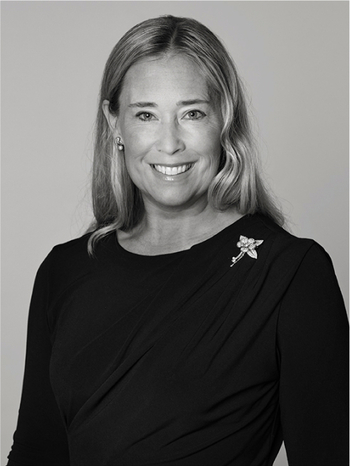Skålfat, fem stycken, porslin. Qingdynastin, ur födelsedagsservisen, Tongzhi.
Insidan med dekor av tecken för dubbel lycka. Utsidan med fyra medaljonger med drake och fenixfågel mot en korallröd grund beströdd med blommor och fjärilar. Fyra tecken i rött. Diameter 9 cm.
En med nagg.
Proveniens
Gustaf Oscar Wallenberg (1865-1937), Stockholm, and thence by descent within the family.
Gustaf O. Wallenberg was a Swedish businessman, diplomat and active politician. He was the son of André Oscar Wallenberg, founder of Stockholm Enskilda Bank (today's Skandinaviska Enskilda Banken, known as SEB). After a career in the Swedish Navy he turned to the business world and was active in improving the transoceanic shipping industry.
Wallenberg was Sweden's Envoy to Tokyo between 1907-1918. In April 1907 he travelled to Beijing to amend the Treaty of Canton (1847) between Sweden-Norway and China and to establish diplomatic relations between Sweden and the Qing Court. As the Swedish Envoy Extraordinary and Minister Plenipotentiary at the Court of Peking, he successfully negotiated and signed with Lien Fang, the Guangxu Emperor's High Commissioner Plenipotentiary and Senior Vice-President of the Wai Wu Pu, the Treaty of Amity, Commerce and Navigation, between Sweden and China, which was signed in Beijing on 2 July 1908, with an additional article signed on 24 May 1909.
The collection was acquired between 1907 and 1918 when Wallenberg was the Swedish Envoy in Tokyo, and possibly during his diplomatic service in China. Documents preserved at the Östasiatiska Museum in Stockholm demonstrate the importance of Gustaf Wallenberg and his extensive connections with the Qing government to the Swedish engineers and businessmen who were in China during this period, such as Johan Gunnar Andersson, Osvald Siren, Orvar Karlbeck, Erik Nordstrom and many more.
Gustaf Wallenberg was the grandfather of Raoul Gustaf Wallenberg (1912-1945), an architect, businessman, and diplomat. Raoul Wallenberg has been designated by Yad Vashem as one of the Righteous Among Nations, as well as having many monuments and streets named after him in honour of him saving thousands of Jews in German-occupied Hungary during the Second World War, while serving as Sweden's Special Envoy in Budapest. As he lost his father the same year he was born, he was brought up also by his grandfather Gustaf Wallenberg, with the Chinese porcelain collection around him, inheriting part of the collection when his grandfather passed away in 1937. He died at a time unknown between 1945 and 1947, further to his detention in Budapest by General Malinovsky in 1944, and arrest by the Soviet authorities. Further to his disappearance his part of the Chinese collection was deposited at the Östasiatiska Museum in Stockholm, and later released to the family.
Utställningar
Compare a large set sold at Sothebys, lot 543. Important Chinese Art, 19 September 2023, New York.
Litteratur
A bowl from this service in the Palace Museum, Beijing is illustrated Zhang Han, 'Xiqing jixiang: Wanqing Tongzhi dahun ciqi pashu [Auspicious: Late Qing Dynasty Tongzhi wedding porcelain]', Forbidden City, vol. 12, 2020, p. 104.
Compare also a large circular box and cover in the Qing Court Collection, likely belonging to the same commission, illustrated in The Complete Collection of Treasures of the Palace Museum. Porcelains with Cloisonné Enamel Decoration and Famille Rose Decoration, Hong Kong, 1999, pl. 231.
Övrig information
This extraordinary assemblage adorned with dragons and phoenixes is believed to have been produced as part of the famous 'Wedding Set' of porcelains commissioned for the marriage of the Tongzhi Emperor in 1872. The preparation for the wedding, including commissions for the porcelain, began in 1867, but the quality of the first shipment was well below Cixi's standard. It was not until the year of the wedding that the imperial kiln submitted works that were deemed satisfactory.
The works in the present service are replete with auspicious designs of marital harmony. The dragon and phoenix, representative of the emperor and empress, are separated by double xi (happiness) characters, repeated to the interiors. Some of the pieces in the service are inscribed 'Yanxi tonghe', a phrase that combines the palaces names for the Tongzhi Emeror's empress and consort in the Forbidden City. As Ying-Chen Peng argues in this catalogue (p. 68), the presence of 'Changchun tongqing' (jointly celebrating eternal spring) inscriptions may also suggest they were commissioned for a wedding banquet to be held in Changchungong, within the Forbidden City.



















































